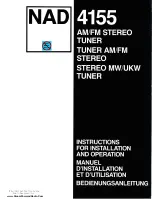
17614_ins_wireless_900_rcvr
Installation and Operating Instructions
Wireless 900 MHz Receiver
Building Automation Products, Inc., 750 North Royal Avenue, Gays Mills, WI 54631 USA
Tel:+1-608-735-4800 • Fax+1-608-735-4804 • E-mail:[email protected] • Web:www.bapihvac.com
Specifications subject to change without notice.
rev. 04/21/15
2 of 5
4. Press and hold down the “Service Button” on the top of the output module (Fig 3) that you wish to train. Then, press
and release the “training button” (see Fig 2) on the room transmitter. When the output module receives the “training
transmission” from the room transmitter, the output module’s red LED will light. Release the “Service Button” on the
output module and the red LED will go out. The transmitter and output module are now trained to each other. During
normal operation, the output module’s LED will flash about once every 20 seconds indicating data reception from the
transmitter trained to it.
Note:
The room transmitter sends both the temperature and humidity information when the “Training Button” is
pressed. However, each Analog Output Module is configured at the time of order as a temperature, humidity,
Setpoint or Override module and will only recognize the relevant information and will ignore the rest.
5. Mount the transmitter at the desired location. If needed, remove the batteries to do so. The units will remain trained
to one another through power failures and battery replacement. Replace the transmitter’s cover and back out the
security screws.
SETPOINT VARIABLE TRAINING
1. To train an output module to a Setpoint variable, select the Setpoint Output Module (SOM) calibrated to the setpoint
range you need and connect it to the wireless receiver. Note: Multiple output modules can be trained to the same
transmitter variable if desired.
2. Apply power to the receiver which will supply power to the connected output modules. The power LED on the
Receiver will light and remain lit.
(Setpoint Output Modules with current output must have loop power supplied
to the module itself before they can be trained.)
3. Remove the cover of the room transmitter and remove the battery tabs or install the batteries, observing polarity as
shown in Fig 2. The small LED at the bottom right of the circuit board, next to the setpoint, will flash approximately
once every 20 seconds, indicating a transmission. (The flash is very quick.)
4. Press and hold down the “Service Button” on the top of the output module (Fig 3). Then, press and release the
OVERRIDE button on the transmitter (See Fig 2). (Note: If the unit was not ordered with an override function, then
the OVERRIDE button will be shorter and will not extend outside the case but will still be accessible upon removing
the cover.) When the output module receives the “Training Setpoint” info from the transmitter, the output module’s red
LED will light. Release the “Service Button” on the output module and the red LED will go out. The transmitter and
output module are now trained to each other. During normal operation, the output module’s LED will flash about once
every 20 seconds indicating data reception from the transmitter trained to it.
5. Mount the transmitter at the desired location. If needed, remove the batteries to do so. The units will remain trained
to one another through power failures and battery replacement. Replace the transmitter’s cover and back out the
security screws
Analog Output Module Training continued...
Mounting and Locating of the 900 MHz Antenna
The 900 MHZ Receiver comes with the “Whip” Antenna but a
900 MHz Extendable Dipole Antenna is also available.
The receiver may be located inside a metal enclosure but the
antenna must be outside the enclosure. The “Whip” Antenna
simply screws onto the receiver. Mounting the receiver and
antenna on a metal surface may block reception from behind the
surface and frosted windows may block reception too.
For the Extentable Dipole Antenna, peal off the protective
film from the adhesive pad and stick the antenna to a wall or
other non-metallic support. Mounting the antenna on a metal
surface may block reception from behind the surface and
frosted windows may block reception too. A wooden or plastic
furring strip attached to a ceiling beam makes a great mount.
The antenna may be hung from any ceiling fixture using fiber or
plastic twine. Do not use wire to hang, and do not use perforated
metal strapping, commonly called plumbers tape.
Fig. 4:
900 MHz “Whip”
Antenna (left) and the
900 MHz Extendable
Dipole Antenna with
79” Cord























